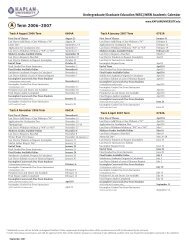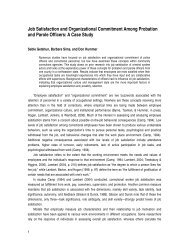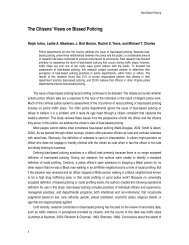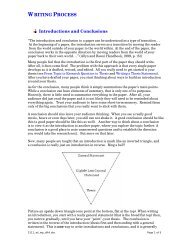Adult Probation Department Mental Health Unit: An Outcomes ...
Adult Probation Department Mental Health Unit: An Outcomes ...
Adult Probation Department Mental Health Unit: An Outcomes ...
- No tags were found...
Create successful ePaper yourself
Turn your PDF publications into a flip-book with our unique Google optimized e-Paper software.
including stress from one’s environment, drug addiction, or symptoms of one’s illness. Theassignment of these probationers to the MHU necessitates the establishment of an approach tomediate any risk of violence and signifies the importance of ongoing officer training.• The percentage of Hispanic probationers (5%) appears low in comparison with their percentage onregular probation. This number is lower than we expected and may be due to cultural factors suchas language barriers or the stigma associated with revealing one’s mental illness to his or herprobation officer. <strong>An</strong>other point of interest is that almost one half of the probationers transferredinto the MHU were internal transfers, suggesting the courts were unsuccessful in determiningmental health issues. This finding suggests the poor identification of mentally ill probationers inpretrial court proceedings. Moreover, it highlights the substantial number of mentally illprobationers under supervision in regular probation units.Several positive outcomes were evident from this study; for example, more than half of the probationersterminated their sentence satisfactorily. Less than one fourth received jail or prison time at the conclusion oftheir sentence. Additionally, more than one half ended their sentences with no violations for new offenses.More than half of all probationers were not hospitalized during the course of their probation. About threefourths of the probationers were domiciled at the conclusion of their sentence with most residing with familymembers. However, nearly one half of probationers were incarcerated at some point during their probation.This outcome suggests the court system uses incarceration as a method to manage mentally ill probationerswho commit new offenses and fail to comply with court mandates. Additionally 60% ended their probationwith no new offenses. Nearly 40% of the probation cases that terminated in 2001 did not re-offend and werenot re-arrested for either a misdemeanor or felony arrest three years after probation was terminated.These data suggest modest success in preventing recidivism and achieving positive sentenceoutcomes. However, additional research needs to be conducted to understand why some probationersdidn’t complete successfully and why others committed new offenses. Our findings further suggest thatadditional longitudinal studies for this population along with a comparison group (of a similar population)would greatly assist in this area. Moreover, this additional research would help guide correctional agenciesin the development, practices, and needs related to treating the mentally ill.Finally, this long-term study offers some guidelines as to how to maintain and produce positive resultsfor the mentally ill probationer in a correctional setting. The level of communication between officers andservice providers along with the state oversight of the MHU has produced a national model in supervisingmentally ill probationers. This study will show other correctional agencies that they can construct a mentalhealth unit that can manage mentally ill probationers effectively in an increasingly complex societalenvironment.AcknowledgmentsSpecial acknowledgement is due Acting Chief Jesús Reyes, Assistant Chief Timothy Bush, Chief VeronicaS. Ballard (retired), Deputy Chief Noel Rivera (retired), and Deputy Chief Regina Nero for their leadershipand support. The authors would also like to thank Research Assistant Laura Rizzardini for help in obtainingdata and Laurie Drda for her assistance in obtaining criminal histories for this research.15
















